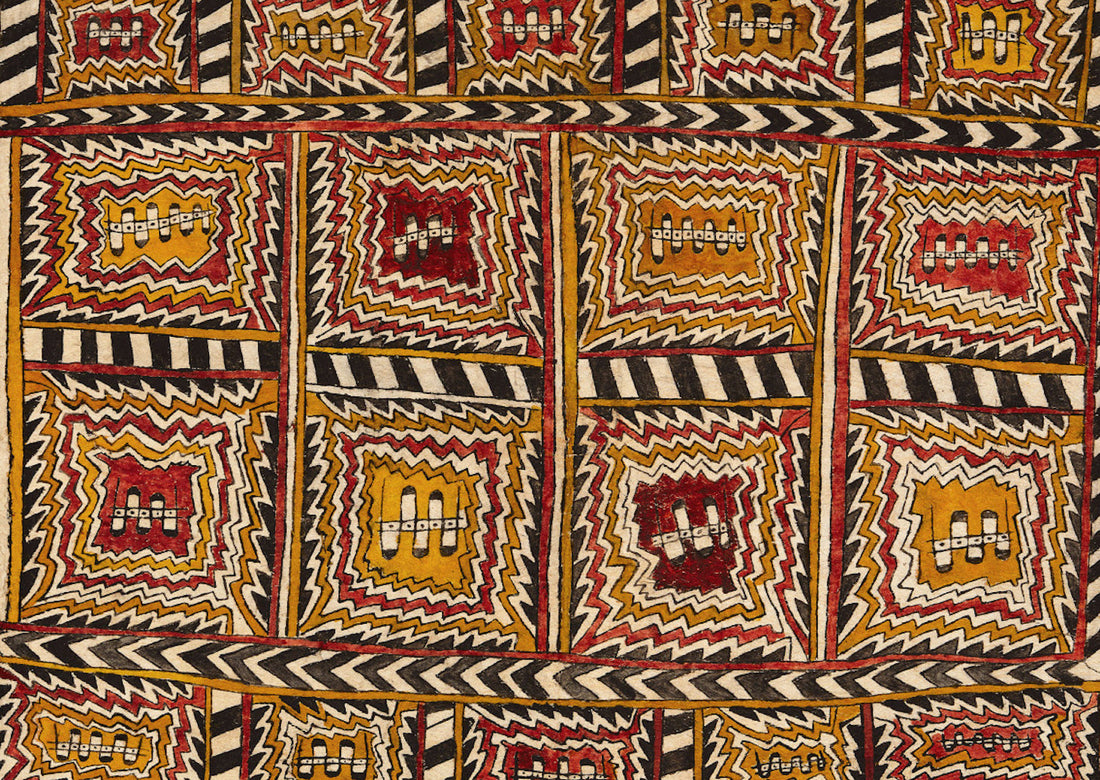
ÖMIE: AN EXHIBITION OF 17 ARTISTS WORKING ON NIOGE (BARKCLOTH)
The Ömie reside in the remote inland mountains of Oro Province in Papua New Guinea. It is here that they create and decorate nioge (barkcloth) in a form of expression where the utilitarian, artistic and sacred coexist. Traditionally, nioge have been used ceremonially and as everyday clothing, however, in more recent years they have also been made for purely artistic appreciation. Primarily, the artists are women and barkcloth painting is their domain, however, there are rare instances of male practitioners who were formally trained by their mothers. Image: Left to right (1) Rosemon Hinana, Aduvahe sihoti'e nioge ohu'o buborianö'e, 2022, appliquéd mud-dyed nioge (barkcloth), 186.5cm x 78cm. (2) Brenda Kesi (Arirè), Wo'ohohe, 2018, appliquéd mud-dyed nioge (barkcloth), 143cm x 82cm. (3) Brenda Kesi (Arirè), Taliobamë'e nioge, 2018, appliquéd mud-dyed nioge (barkcloth), 119cm x 66cm. (4) Patricia Warera (Matomguo), Wo'ohohe, 2021, appliquéd mud-dyed nioge (barkcloth), 137cm x 79cm. (5) Rosemon Hinana, Jö'o sor'e sihoti'e nioge ohu'o bubori anö'e, 2022, appliquéd mud-dyed nioge (barkcloth), 147cm x 68.5cm. Image courtesy of the artists & Daniel Browne. Above image: Diona Jonevari (Suwarari), Dahoru’e, bubori anö’e, vë’i ija ahe, odunaigö’e, jö’o sor’e, sabu ahe, siha’e, taigu taigu’e ohu’o douhia’e soré, 2022, natural pigments on nioge (barkcloth), 147cm x 83cm.
Image: Left to right (1) Rosemon Hinana, Aduvahe sihoti'e nioge ohu'o buborianö'e, 2022, appliquéd mud-dyed nioge (barkcloth), 186.5cm x 78cm. (2) Brenda Kesi (Arirè), Wo'ohohe, 2018, appliquéd mud-dyed nioge (barkcloth), 143cm x 82cm. (3) Brenda Kesi (Arirè), Taliobamë'e nioge, 2018, appliquéd mud-dyed nioge (barkcloth), 119cm x 66cm. (4) Patricia Warera (Matomguo), Wo'ohohe, 2021, appliquéd mud-dyed nioge (barkcloth), 137cm x 79cm. (5) Rosemon Hinana, Jö'o sor'e sihoti'e nioge ohu'o bubori anö'e, 2022, appliquéd mud-dyed nioge (barkcloth), 147cm x 68.5cm. Image courtesy of the artists & Daniel Browne. Above image: Diona Jonevari (Suwarari), Dahoru’e, bubori anö’e, vë’i ija ahe, odunaigö’e, jö’o sor’e, sabu ahe, siha’e, taigu taigu’e ohu’o douhia’e soré, 2022, natural pigments on nioge (barkcloth), 147cm x 83cm.
Nioge textiles are often made by women and used as personal adornment, domestic comfort, and ceremonial purposes. Ömie tapa, or “night” in Ömie language, is beaten barkcloth made from the inner bark or bast of rainforest fig trees, including banyan for a darker brown colour and the paper mulberry tree for lighter almost white tapa. The process of creating nioge is a time-consuming process that involves many stages and requires a high degree of skill.
First, the bark is collected - the inner bark is harvested from the tree and separated from the outer bark. The inner bark is then rinsed and soaked in water for several hours, softening it before the next stage. It is then laid on a flat surface and beaten with a wooden mallet, this time to make it thinner and more pliable.
Image: Brenda Kesi (Arirè), Taliobamë'e nioge, 2018, appliquéd mud-dyed nioge (barkcloth), 119cm x 66cm. Images courtesy of the artists & Daniel Browne.
The pigments and dyes used to paint and dye the barkcloths (predominantly reds, yellows, greens, blacks and deep greys) are all procured from the abundant rainforests that surround the Ömie, such as ferns, fruits, leaves, coconut charcoal, tree sap and volcanic mud. The intricate designs are either painted onto the barkcloth using strong grasses or fashioned wooden sticks (called ije), with frayed betelnut husk brushes. The completed nioge is then dried in the sun, sometimes over several days. Some barkcloths with the most ancient origins have a minimal aesthetic, and the process involves dyeing the barkcloth in volcanic river mud. The designs are then appliquéd using a fine bat-wing bone needle.
Image: Albert Sirimi (Nanati), Ujavu am'e (guai); taigu taigu'e; juburi anö'e; ahéhuruvë'e; nuni'e; ohu'o sabu ahe, 2012, natural pigments on nioge (barkcloth), 160cm x 65cm.
The styles of the exhibiting artists vary vastly, from the densely patterned and hallucinogenic aesthetic of the late Albert Sirimi (Nanati), to the more reduced and monochromatic designs of Patricia Warera (Matomguo). What unites all the work, however, is an expression of Ömie culture. As Ömie Artists Manager, Brennan King, states, there is "... the sense of one united cultural identity... this can be seen and sensed in Ömie barkcloth paintings - despite the great diversity of symbolism there is a distinct 'Ömie essence'."
Image: Diona Jonevari (Suwarari), Se'a hu'e, dahoru'e, bubori anö'e, vë'i ija ahe, odunaigö'e, jö'o sor'e, sabu ahe, vinohu'e ohu'o siha'e, 2021, natural pigments on nioge (barkcloth), 164cm x 70.5cm. Image courtesy of the artists & Daniel Browne.
Nioge can be conceived as a library of sorts, containing ancient information about Ömie cosmology, their belief systems and the natural world in general. A Western analogue, though not an exact equivalent, would be illuminated manuscripts. There is also a seriousness attached to their construction and only particularly refined barkcloths by accomplished artists are exhibited by Ömie Artists. Moreover, the artists must first master the inherited clan designs of their ancestral lineage. Until they reach a certain level of proficiency and social status, they cannot use their uehore (wisdom) to create new designs. The Ömie's artistic practice is also, in part, informed by the Ömie creation story, in which the first woman, Suja, created a barkcloth and dyed it with red volcanic river mud to celebrate her new-found fertility. There is thus a ritualistic aspect to the making of barkcloths and their creation is, in some sense, a re-enactment of Suja's actions. Implicit in this is also a celebration of fecundity and the creative forces of nature.
Want to find out more?
You can read about the work of Ömie artist, Ilma Savari, in Selvedge issue 112: Wonder. Savari celebrates the traditional textile practice of Ömie culture, focusing on bringing natural materials to the forefront. Her nioge textile paintings are made from barkcloth and capture stories of spiritual teachings through distinct patterns and colours.
Ömie, a group exhibition of 17 artists working on nioge (barkcloth), in association with Ömie Artists, is on show at the JGM Gallery until 27 May 2023. Find more details visit the JGM Gallery website here.

1 comment
These are truly remarkable works of art! I am familiar with traditional bark cloth but Nioge is new to me. I would like a book on this art form.